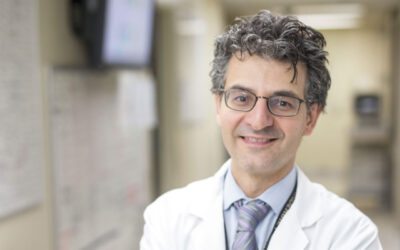By Matt Skoufalos

John and Deborah Mayes smile for the camera. The two met when John taught Deborah at Fort Sam Houston.
Growing up on a small farm near Greenfield, Iowa, John Mayes remembers driving tractors and doing field work from the time he was 11 years old. His family lived 3.75 miles outside of the closest town, Mayes said he “felt like we were in the middle of nowhere, but it was a good life.”
“The family didn’t have much money, but there was always plenty of food on the table,” he said. “I don’t think we ever had a car that was newer than a four-year-old model until the kids were out of the house. We grew what we ate, and Mom could sew patches on top of patches on the blue jeans that Dan and I wore.”
The resiliency of farm life fed Mayes’ aptitude for learning, which itself led to new opportunities. In need of a trainer, Mayes’ high school wrestling coach invited the rising freshman to take home materials for a correspondence course from a medical supply company that would teach him the basics of sports medicine. Mayes completed the course, and became the student trainer for his high school football and wrestling teams, a role he continued at the University of Northern Iowa, and which provided the foundation for his interest in a career related to medicine.
In 1971, when Mayes was graduating with a degree in secondary education, the United States was two years into a national draft lottery to enlist young men into the Vietnam War effort. Mayes’ lottery number was five, which put him at the top of the list for his Iowa county. To avoid being drafted — with no choice of military specialty — into the artillery or infantry divisions, he chose to enlist in the U.S. Army to pursue an assignment as a combat medic.
Mayes arrived early for his orientation at Fort Sam Houston, and was assigned to the motor pool for a time, learning how to drive Jeeps and two-and-a-half-ton Army vehicles. He recalled one conversation with a colonel during which he told the senior officer of his intention to become a combat medic.
“He gave me a side eye and said, ‘I suggest you go to something a bit more challenging,’ ” Mayes said. “I later learned before medic training that medics were the ones with the ‘targets’ painted on their helmets. And that’s how I got to X-ray school.”
In X-ray school, Mayes wasn’t only the honor graduate of his class, but because he held a teaching degree, and the base was already critically short of military instructors, he was invited to become an instructor, teaching new recruits the information he’d just learned. He remained at Fort Sam Houston for the next three years of his enlistment contract. In 1974, when several military jobs were converted to civilian positions, Mayes extended his stay another 30 years. Over the course of three decades, he educated more than 12,000 X-ray technologists, including seven sets of fathers and sons, and Deborah, the woman who would become his wife and mother to their two children.
“It was a fun job,” Mayes said. “It was new people and new classes, and the Army’s X-ray program was huge. We were teaching 10 classes a year, 44 students per class, and then for a while, double-shifting to 88 students, graduating 880 techs a year. It was the biggest X-ray school in the world. It was almost like you were in college again because all the students were so young.”
Along the way, Mayes expanded his own education, completing a dual master’s degree in management and human relations from Webster University in 1978, and becoming an early adopter of personal computing technology in the early 1980s. Learning programming on a Commodore 64 turned a knack for mathematics into an aptitude for database management that became “life-changing,” Mayes said.

The Red Rocket is a PVC-framed, battery-assisted pedal car John Mayes built during the COVID pandemic.
“I enjoyed numbers and making balances come out exactly right, accuracy, and grade-point averages. I subscribed to a couple of magazines, and typed in my own program to have a word processor, and my own program to have a database. Everything was stored on a cassette tape, which was the earliest storage device for the C64,” he explained.
At X-ray school, Mayes and another instructor who had a personal computer would bring their Commodores into the facility to process grades and update class rankings. Eventually, he began tracking all students’ records and academic averages. But to Mayes, “I was just a cog in the wheel doing a necessary function.”
In 2004, after his retirement, Mayes was considering the next phase of his career when he ran into Warren Parker, a former colleague from the service. He told Parker he was considering starting a company to offer continuing education seminars, and together with a third partner, the trio established a business to do just that. A month-and-a-half after their early discussions, they launched South Texas Associates of Radiology (STAR).
Mayes’ role was to handle the back end needs of the business, manage its databases, keep the books, maintain its web presence and create certificates for students completing coursework. In 2015, the company expanded to offer a telepresence in addition to its in-person schooling, and during the novel coronavirus (COVID-19) pandemic, began offering webinars exclusively. Now, as he mulls a second retirement, Mayes regards the life he’s led since leaving the farm in Iowa in a much broader focus.
“My goal way back then was maybe to be a high school teacher, and I didn’t really have aspirations beyond that,” he said. “Ninety percent of people change course at some point; everything happens for a reason.”
Neither has he lost his loves of tinkering and service. Mayes’ quarantine project, a PVC-framed, battery-assisted pedal car, has become an amusement to share with his wife and grandchildren. Nicknamed “The Red Rocket,” the car is “a big hit with the neighbors” in his San Antonio community, but it’s not the only driving Mayes does these days.
He’s also an active volunteer with North East Senior Assistance, through which Mayes spends some mornings taking ambulatory seniors to medical appointments, and organizes senior game days and luncheons for the community associated with his church, Windcrest United Methodist. It’s much-needed social connection for the people in his community, but Mayes shrugs off any praise for his efforts, saying instead, it’s just “something I can do to help.”
“It’s been a good life,” he said, simply. “I have no regrets about anything.”








